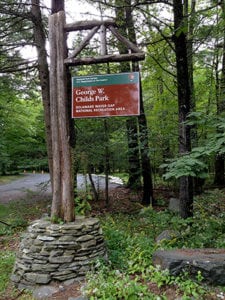How best to use the DWG park? Your input requested
People interested in the future of the Delaware Water Gap National Recreation Area gathered at the Matamoras, Pa., firehouse on Friday, Sept. 11, to talk with representatives of the park at one of three public scoping sessions on the Visitor Use Management Plan. Below, the George W. Childs Park, one of the popular sites in the Delaware Water Gap National Recreation Area that saw stress from heavy use during this past summer's weekends. PHOTOS BY MEG McGUIRE
HOW DO YOU WANT to use the Delaware Water Gap National Recreation Area?
How many people can one park hold is an important question for any park. A park like Central Park in New York City will have a different answer than a park like the Delaware Water Gap National Recreation Area.
Finding the right answer to that question for this park is the reason about 50 people were gathered in the Matamoras, Pa., firehouse on Sept. 11, one of three public scoping sessions the DWG staff held to get public input into the third stage of the Visitor Use Management Plan.
This park, which hugs the Delaware River from just south of Milford, PA to just after its namesake (the Delaware Water Gap), is a 70,000-acre retreat from the busy world, and the last thing the folks who are looking for peace and quiet want is too many other folks looking for the same thing.
You might think that all those acres would be ample to hide even a very large crowd, but the problem isn’t really numbers. There are areas of the park which are empty while others are jam packed.
For example, one of the stress points this past summer has been the George W. Childs Park in Dingmans Ferry. While park officials are anxious not to appear to be scolding anyone, they did need the services of law enforcement to help them police the crush of people at the park. It’s one of the gems of the DWG park and includes short hikes along its three cascading waterfalls and a picnic area.
There are two overarching goals for park management. One is to encourage human use of the park in ways that respect all other uses and the other is to protect the natural resources that make the park unique.
There is some tension among all the possible uses of the park. Some fisherfolk would likely be happy if there was less swimming and maybe even less boating. Some folks who are interested in the unique and various habitats that the park encompasses would likely prefer if humans were banned from many areas. Others are interested in how the park wants to handle the 700-plus buildings that are of historical interest.
There have been several stages where citizen involvement has been encouraged, and there’s still time to get your opinion heard. There’s an open comment session on line until October 9.

